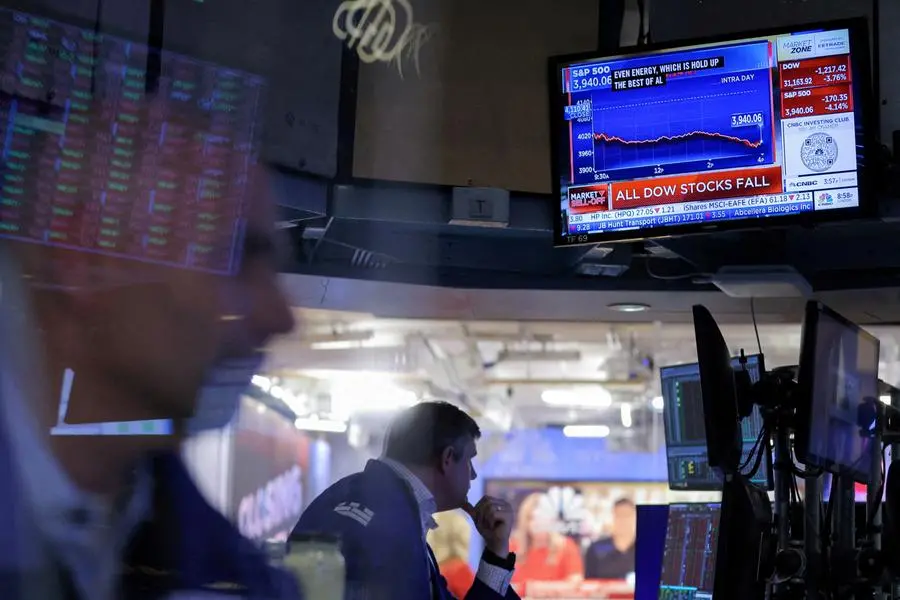PHOTO
NEW YORK - As markets dial down expectations for U.S. interest rate cuts this year, America's largest corporations are poised to rely more heavily on their stock and a bulging cash hoard instead of expensive debt to finance acquisitions.
Since the start of 2023, the volume of mergers and acquisitions financed by stock or a mix of cash and stock has touched its highest level in more than two decades, according to data from LSEG.
All-stock M&A transactions accounted for $263.6 billion, or about 24% of overall announced volumes so far this year - the highest percentage year-to-date since 2001 when the comparable figure was 47.2%, according to LSEG.
Cash-and-stock deals have accounted for 10.8% of total announced transaction volumes this year, which is the highest level since year-to-date 2021 when the figure was 17.5%. Put together, all-stock M&A volumes, including the common stock value of cash-and-stock transactions, has accounted for roughly 29% of total deal volumes so far this year - the highest percentage since 2001 when the figure was 30.7%.
Several investment bankers, deal lawyers, and Wall Street analysts expect this funding strategy to gather pace this year, as hopes of near-term interest rate cuts fade and debt borrowing costs are expected to remain higher for longer.
"When corporates feel good about their currencies, they tend to use stock for deals - and at the same time, they don't want to get over-leveraged (by taking on debt)," said Ivan Farman, co-head of global M&A at Bank of America.
"People are being a little more cautious about how they approach their capital structures," he added.
Since the start of 2023, all-stock mergers have accounted for 19.5% of overall volumes - the prior ten-year average of all-stock M&A deals as a percentage of overall volumes is 14.8%, according to LSEG.
Notable stock deals this year including Capital One's $35 billion takeover of credit card rival Discover Financial; Diamondback Energy's $26 billion acquisition of Endeavor Energy that was mostly funded with stock; and BlackRock's $12.5 billion deal for Global Infrastructure Partners that was also funded primarily with stock.
The trend has continued with companies showing an inclination to use cash and stock for acquisitions.
In April, IBM said it will acquire HashiCorp for $6.4 billion using cash on hand and BHP Billiton made an all-stock bid to acquire Anglo American that was rejected.
As opportunistic buyers have aggressively pursued targets whose share price has nosedived, they have often used stock as acquisition currency to bridge differences on valuation with sellers.
"From the seller's perspective, a stock deal is a sharing of the value creation from synergies - and if it's a cash deal, you're cashing your shareholders out at a specific price for a specific premium," said Mark McMaster, global head of M&A at Lazard.
"For some of these strategic combinations, it's easier or more compelling to offer stock, because it represents a combination, and a true sharing of the synergies amongst the buyer and seller," added McMaster.
TURN IN SENTIMENT
Overall M&A volumes are expected to rise 50% in 2024, Morgan Stanley analysts said in a March report, largely due to pent-up demand from last year when volumes touched a decade-low.
But expectations of how they will be financed has taken a sharp U-turn from earlier in the year as some investors are pricing in just one or two U.S. rate cuts this year compared to three.
So far this year, investment-grade rated companies raised nearly $71 billion of debt to fund M&A transactions at a faster pace than the last three years, according to Informa Global Markets data.
This tally was expected to touch $175 billion to $200 billion by the end of the year but now only another $60-70 billion of known transactions are expected to be funded in the debt markets this year, said Scott Schulte, head of U.S. investment-grade syndicate desk at Barclays Capital.
It would take the total amount raised for mergers in 2024 above 2022 and 2023 levels but below the $173 billion in 2021, according to Informa data.
Investment-grade companies may still take on debt but it could be bonds with greater prepayment flexibility like term, bridge loans and commercial paper with far shorter maturities, said Schulte.
For private equity firms, exiting highly leveraged transactions in this higher-for-longer environment would eat into their total returns, said Ruth Yang, global head of private market analytics at S&P Global Ratings.
Leveraging up would increase rating downgrade risk so they could use cash and stock for any acquisitions, she added.
Global listed non-financial corporations currently hold $5.6 trillion in cash on their balance sheets, while the biggest private market investors have $2.5 trillion of dry powder at their disposal for dealmaking, according to the Morgan Stanley report.
Companies may prefer smaller strategic transactions via “bolt-ons” or divestitures, with the former funded with cash or stock, said Edward Marrinan, credit strategist at SMBC Nikko Securities.
"Higher borrowing costs, a stringent regulatory environment and the trend toward de-globalization leaves many companies more cautious about undertaking large transformative acquisitions," said Marrinan.
(Reporting by Shankar Ramakrishnan and Anirban Sen in New York; Editing by Anna Driver)





















